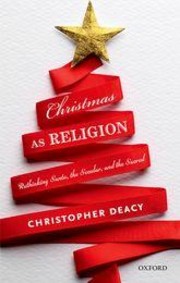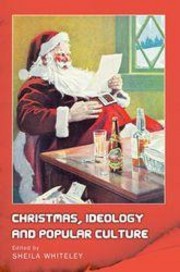As Christmas approaches, we take a moment to look at the research on an important part of the season: the big man in red.
Who is he? Or… is he?
In the 1990s, Gallup Canada pollsters asked respondents who had already confirmed that they celebrated Christmas whether or not they believed in Santa Claus. Of course, “belief” can be a complicated concept when it comes to a tradition tied into spiritualism.

- Santa Claus: Good or bad for children?
- Encounter with reality: Children’s reactions on discovering the Santa Claus myth
- Ho! Ho! Who? Parent promotion of belief in and live encounters with Santa Claus
- The role of fantasy figures in the regulation of young children’s behavior: Santa Claus, the Easter Bunny, and donations
- Terrorism, altruism, and patriotism: An examination of children’s letters to Santa Claus, 1998–2002
- Santa Claus is coming to town: religious belief and ontological claims
- A child’s Christmas in America: Santa Claus as deity, consumption as religion
- Santa Claus and the Tooth Fairy for the Jewish child and parent
The dark side of the Claus
Of course, in earlier decades pollsters wouldn’t even think of asking adults if they believe in Santa. Int eh 1950s and 1960s, in fact, Gallup asked Canadians whether they felt it was harmful to tell their children about Santa Claus.

- Santa Claus does more than deliver toys: Advertising’s commercialization of the collective memory of Americans
- Christmas, Santa Claus, Sugarplums and the Grinch
- Postmodern tourism: The Santa Claus Industry
Further reading

Christmas as Religion: Rethinking Santa, the Secular, and the Sacred
This book begins with the premise that religion plays an elementary role in our understanding of the Christmas festival, but takes issue with much of the existing literature which is predilected to associate ‘religion’ with formal or institutional forms of Christianity or to construe Christmas as a commercial and secular holiday. In Christmas as Religion, Deacy argues that such approaches fail to take adequate stock of the manifold ways in which people’s beliefs and values take shape in modern society. It may be, for example, that a supernaturally-themed Christmas film about Santa or a Christmas radio programme such as Junior Choice comprise a non-specifically Christian, but nonetheless religiously rich, repository of beliefs, values, sentiments, and aspirations. This book thus makes the case for laying to rest the secularization thesis, with its simplistic assumption that religion in Western society is undergoing a period of escalating and irrevocable erosion, and to see instead that the secular may itself be a repository of the religious. Deacy argues that a festival of consumerism can be an unexpectedly fertile site of spirituality and transcendence and that materialism and consumption need to be understood within a context of familial, social, and interpersonal connection and, even, transformation. Rather than see Christmas as comprising an alternative or analogous form of religious expression, or dependent on any causal relationship to the Christian tradition, Deacy’s premise is that it is religious per se, and, moreover, it is its very secularity that makes Christmas such a compelling, and transcendent, religious holiday.

Christmas: A Candid History
Written for everyone who loves and is simultaneously driven crazy by the holiday season, Christmas: A Candid History provides an enlightening, entertaining perspective on how the annual Yuletide celebration got to be what it is today. In a fascinating, concise tour through history, the book tells the story of Christmas–from its pre-Christian roots, through the birth of Jesus, to the holiday’s spread across Europe into the Americas and beyond, and to its mind-boggling transformation through modern consumerism. Packed with intriguing stories, based on research into myriad sources, full of insights, the book explores the historical origins of traditions including Santa, the reindeer, gift giving, the Christmas tree, Christmas songs and movies, and more. The book also offers some provocative ideas for reclaiming the joy and meaning of this beloved, yet often frustrating, season amid the pressures of our fast-paced consumer culture. DID YOU KNOW For three centuries Christians did not celebrate Christmas? Puritans in England and New England made Christmas observances illegal? St. Nicholas is an elf in the famous poem “The Night Before Christmas”? President Franklin Roosevelt changed the date of Thanksgiving in order to lengthen the Christmas shopping season? Coca-Cola helped fashion Santa Claus’s look in an advertising campaign?

Christmas, Ideology and Popular Culture
How do we understand Christmas? What does it mean? This book is a lively introduction to the study of popular culture through one central case study. It explores the cultural, social, and historical contexts of Christmas in the UK, USA, and Australia, covering such topics as fiction, film, television, art, newspapers and magazines, war, popular music, and carols. Chapters explore the ways in which the production of meaning is mediated by the social and cultural activities surrounding Christmas (watching Christmas films, television, listening or engaging with popular music and carols), its relationship to a set of basic values (the idealised construct of the family), social relationships (community), and the ways in which ideological discourses are used and mobilised, not least in times of conflict, terrorism, and war. Packed with examples ranging from Charles Dickens’ seminal text, A Christmas Carol, Coca-colonisation and Santa Claus, Victorian cartoons and Christmas cards, to Dr Who, The Office, ‘A Fairy Tale of New York’, ‘Happy Christmas (War is Over)’, and such dystopian films as Jingle All the Way and All I Want For Christmas, the case studies offer an incisive account of the ways in which Christmas relates to social change, and how such recent events as 9/11 and the continuing conflict in Iraq focus attention on traditional themes of community and family.
